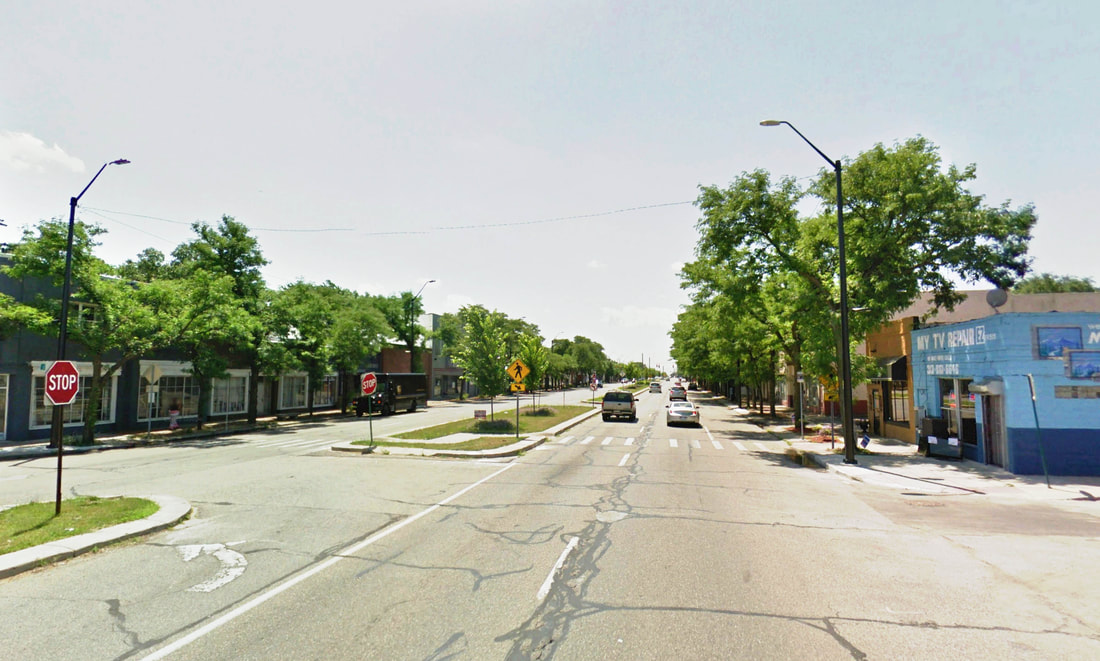| For decades, the City of Detroit has been known as “Motor City” due to longstanding status as the center of the automotive manufacturing industry within North America. As an indirect result of this history, many of Detroit’s streets had been designed to prioritize vehicular travel over public transportation, bicycle access, and pedestrian walkability. However, in recent years, new research has shown that there are measurable benefits that come from prioritizing all modes of transportation equally. This concept is called “complete streets” based on the idea that the street can effectively support several different modes of transportation at the same time. In 2018, the City of Detroit’s Department of Public Works - Complete Streets Division announced that seven key commercial corridors had been systematically identified as roadways that would benefit from a reconfigured streetscape based on these “complete streets” design principles. The first of these streetscape projects to officially begin was Livernois Ave between Margareta Street and 8 Mile Road. This area of Livernois Ave has been nicknamed the “Avenue of Fashion” thanks to its history of supporting locally-owned clothing stores, hair salons, and makeup shops, along with many well-regarded restaurants and one of Detroit’s oldest jazz clubs. NTH provided the construction plans and specifications to give Detroit’s “Avenue of Fashion” a complete makeover based on proven civil engineering designs and site layout practices. | |
As part of this redesign, NTH provided striping, maintenance of traffic, and staging plans to route traffic, and provided locations of temporary parking lots to promote access to businesses during construction. A proposed sequence of construction plan was designed by NTH and refined with input from the City and local representatives alike.
NTH provided geotechnical investigations to determine soil conditions and feasibility of bioretention facilities on-site. NTH’s findings confirmed that bioretention areas would be a practical, sustainable way to manage stormwater runoff by infiltrating captured stormwater back into the soil. These geotechnical investigations also helped determine the behavior or the subgrade beneath the proposed roadway which factored into the pavement design. Since the roadway was being completely redesigned, NTH was able to create a new geometric design for the roadway’s vertical curves, which changed the stormwater flow regime substantially. NTH created utility plans that captured the runoff and decreased flooding, which was an issue previously. This new storm sewer layout had to tie-in with the previous sewer layout, and NTH was able to incorporate existing utilities and connections where possible, and NTH routed the new utilities in an efficient way that avoided many potential conflicts. These stormwater routes were refined by performing hydraulic and hydrologic analyses to ensure that the previous roadway drainage design would adequately serve the re-configured roadway design.
NTH also provided construction administration by answering submittals and Requests for Information as applicable during the construction process. As site conditions varied and new information was taken into account during construction, NTH provided several updated construction and grading plans as dictated by these unforeseen conditions. This ultimately saved time and money for the contractor and the owner by being responsive to the sometimes-unpredictable nature of the construction process. NTH’s adaptability and responsiveness kept the project on track during the height of construction season.




 RSS Feed
RSS Feed